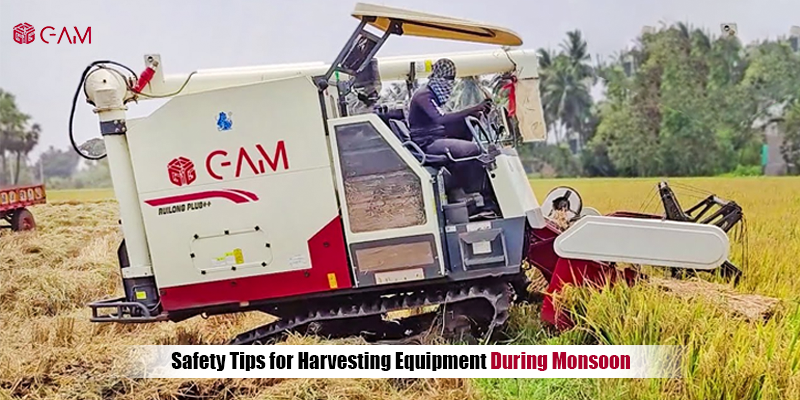Rainfall in India is a blessing; however, excessive rainfall can also pose unnecessary challenges for farmers who rely on harvesting equipment like a multi-crop harvesting machine. Using such machinery in muddy, wet, and unpredictable rainfall can be risky, not just for the harvester but also for the farmer operating it.
This is why, in today’s blog, we will discuss how you can safely use Godabari Agro’s multi-crop harvesting machine without damaging the crop or getting hurt. So, tag along with us until the very end of the blog and learn the safety tips and tricks of using agricultural machines for 100% effective results.
The Common Monsoon Harvesting Risks Faced by Indian Farmers
Most of the time, the harvesters or farmers face the following challenges during the rainy season:
-
Slippery Surface and Machine Slippage
It’s evident that during monsoon, wet soil reduces traction. This can cause the crop cutting equipment to slip or tip over, leading to increased wear on the wheels and tracks.
-
Electrical Hazards
Electrical hazards are a big problem; rain and exposed wiring can cause short circuits. In fact, there’s a high risk of electric shock if the machines aren’t adequately insulated. Using portable electric tools near a wet surface is very risky and even fatal.
-
Poor Visibility
Poor visibility due to fog, rain, or cloudy conditions increases the chances of collision, crop damage, or running over objects.
-
Soil Compaction and Crop Damage
Heavy harvesters can sink into soft soil, and this can affect root growth and soil health for future seasons.
-
Operator Fatigue and Impulsive Decisions
Most of the time, long hours, bad weather, and pressure to finish the harvest fast can lead to mistakes. During this process, most of the time, unplanned shortcuts result in injuries to the farmers or machine breakdowns that can’t be repaired.
Choosing the right Multi-Crop Machine for Monsoon Season
While monsoons are unpredictable, choosing the right multi-crop machine is essential. Do refer to the following features you must look for in a harvester:
- Wide Tires or Rubber Tracks for Better Grip
During the rainy season, soft and muddy soil is one of the biggest obstacles for heavy machines. For which, choosing wide tires or Godabari Agro’s rubber track is the best option. Why? Because wide tires increase surface area and distribute the machine’s weight more evenly in the field.
On the other hand, rubber tracks offer better traction and flexibility on uneven and slippery terrain. This prevents the machine from sinking or getting stuck, and not just that, this also ensures that it protects the field from deep ruts and soil damage. This will result in reduced fuel consumption and lower mechanical strain as the machine doesn’t have to work extra hard to pull itself out of the mud.
(Also read from our previous blogs: How Beneficial Are Rubber Track Tractors in India?)
-
Low Ground Pressure to Prevent Soil Damage
If the soil is saturated, heavy harvesting equipment can compress the ground. This can not only damage the soil structure but also affect your long-term soil health and future yields. So when you choose low ground pressure, it helps maintain soil porosity, which is essential for root health and water drainage.
Besides, it also plays a significant role in reducing the risk of compaction, which can decrease fertility and water absorption and prevent the machine from creating deep tracks, ensuring the drainage channels are not damaged during the process.
-
Automatic Sensors for Alignment and Obstacle Detection
When technology has evolved to make farming smarter and safer, why not use it to the fullest? Automatic sensors ensure that the modern farm harvesting machine is aligned with crop rows, especially when visibility is poor. Plus, it detects obstacles like big stones, uneven ground, water puddles, and even animals to help you reduce crop damage, machine malfunction, and injuries.
Must-Haves During Monsoon With Agricultural Harvesting Machinery
Being prepared is the best solution when harvesting on wet, paddy, and muddy land. Ensure you have the following for a successful and safe harvesting experience. However, first, begin by inspecting the following:
- Brakes, lights, and tracks are working fine.
- Test whether the safety switches and emergency buttons are working perfectly.
- Ensure the belts and the hydraulic systems are tight and are not leaking.
- Finally, ensure no cracked wires are exposed.
Apart from that, do remember to carry the following equipment for a safer experience:
- Non-slip boots
- Water-proof gloves
- Headlamps and flashlights (Best suggested: Waterproof)
- High-visibility raincoats
- And, finally, a first aid kit
Other Safety Tips
The following are some of the other essential safety tips you must follow:
- Always drive slowly and steadily.
- It is better to stick to pre-planned harvesting roads.
- Always use low gears for better grip in wet and muddy conditions.
- Do not allow extra passengers with you, even in the harvesting equipment for small farms.
- Do not park near electric poles and wires.
- Always carry a walkie-talkie or a mobile phone for emergencies.
- Finally, keep all the electrical panels covered.
Bottom Line
When you invest in Godabari Agro’s harvesting equipment, you choose safety. Our machinery is modern and comes with sensors that allow you to have a perfect crop harvesting, even during rain. However, it is your responsibility also to take precautions so you do not accidentally hurt yourself or damage the crop, as it can be hazardous economically for you. So, take precautions and have a happy harvesting this rainy season.
Have questions? Get in touch with us for more expert advice. Contact us here.

